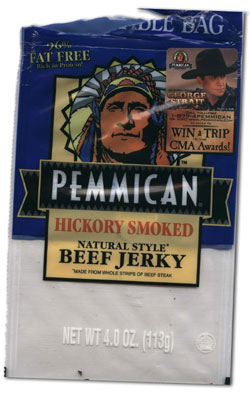| ||
The original powerbar
by Ari LeVaux Sometimes I go hunting in the morning, planning to return by noon, only to extend my hunt to accommodate extenuating circumstances: too much fresh sign, too much fun, too long a hike to even get there or, once in a while, because I bag something. It seems like no matter what my plan, unless there’s something in town I must return for, I stay out until I’m out of food. I choose food that will provide three types of energy: items for short-term burst (chocolate-covered espresso beans, Snickers, shot-blocks, which hit and fade quickly); medium-range carbo-rich snacks, which take about half an hour to hit (wild rice, sesame sticks, dried fruit, bread); and long-term foods (smoked salmon, cheese, jerky), which contain protein for body re-building and fat for extended energy release. This diet gets me through an all-day excursion, possibly in cold, rain, snow or all of the above. But my friend Buck has a better meal plan. An outdoorsy twentysomething who has his own homemade buckskin outfit, Buck wasn’t satisfied with conventional energy bars, which are too much like candy bars – perhaps with brown rice syrup instead of sugar, but the same basic paradigm. “I wanted more meat and fat,” Buck says. Buck and a friend like to climb mountains in the dead of winter, including a 6,000-foot, straight-up bushwhack that’s difficult in any season, and certifiably extreme in winter. “I used to pack all kinds of snacks for the climb,” he explains. “PB&Js, sesame sticks, chocolate … then one time, I decided to just bring a jar of pemmican and a spoon.” After a successful, hunger-free hike, Buck realized that pemmican is for real. A Cree word that literally means “manufactured grease,” pemmican is a Native American food, once widespread around North America. It stores well – it’s been known to last 20 years wrapped in buckskin – and it was the preferred food for of hunters and travelers who needed a lightweight nutrient- and energy-rich food supply. In its simplest form, pemmican is a pounded mix of dried meat and rendered fat. Depending on the region where it’s made, sweeteners like honey or berries are added. In Buck’s kitchen, he runs dried deer meat through an electric grinder. Before the meat was dried, it was pounded. (“The more you obliterate the meat before you dry it, the easier it is to pulverize it later.”) After pounding, the meat was dried on the lowest temperature setting of his dehydrator. “Certain enzymes can get denatured at high heat,” he explains. “So I don’t heat it above the temperature of a really hot day, say, 110 degrees.” When the meat powder comes out of the dehydrator, it looks like dust. “One of the reasons it’s the perfect energy food is that the hard work has been done,” Buck says. “The proteins are already masticated.” Next, he runs “a couple handfuls” of dried blueberries (huckleberries, cranberries, blackberries and others work too) through the grinder. “This can all be done in a mortar and pestle too,” he explains. Buck measures the ingredients by eye – the natives, of course, didn’t have measuring cups. He puts about 10 times as much meat as berries, explaining, “With berries, you can’t go wrong because it’s like, if you got ’em.” Next, he scoops home-made rendered fat from a Mrs. Renfro’s Salsa jar. Buck rendered it by boiling chunks of raw organic beef fat in water, then straining out all the meat bits and other pieces of non-fat, and then boiling off the excess water. Deer fat can also be used, he says, but is more waxy and less creamy. The best pemmican, Buck believes, is made from bone marrow fat. He heats the rendered fat in a skillet, pours the hot grease into a cup, and lets it cool until he can stick his finger in it without too much pain. (From a man who climbs mountains in winter for fun, I’m not entirely clear on his concept of pain.) “I don’t want to denature the honey enzymes by heating it too much,” he explains. When cooled to finger-comfort, Buck mixes the grease with honey (3:1, fat to honey) and combines this mixture with the meat powder (3:1, meat/berry powder to honey/fat). He mixes it all in a bowl (“you want it soft, but holding together”) and then presses the brown mixture into a rectangular slab on a piece of wax paper, which he folds around the finished pemmican. I put some in my mouth. It is soft and easy to chew, with tiny chunks of gristle that somehow evaded Bucks efforts to obliterate and pulverize them. I can taste the nutrient-density; it tastes good. Not the kind of snack you want to munch on the couch, but when you’re working hard outside and need to stoke the fire inside, pemmican is what you need. He gave me a slab, which I’m taking on my next hunt. •
|


